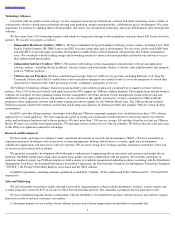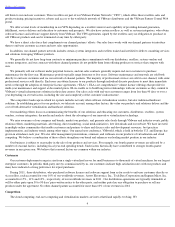VMware 2011 Annual Report Download - page 20
Download and view the complete annual report
Please find page 20 of the 2011 VMware annual report below. You can navigate through the pages in the report by either clicking on the pages listed below, or by using the keyword search tool below to find specific information within the annual report.
Table of Contents
increasingly sophisticated needs of our customers or that interoperate with new or updated operating systems and hardware devices or certify our
products to work with these systems and devices. As a result, we may not be able to accurately predict the lifecycle of our software solutions,
and they may become obsolete before we receive the amount of revenues that we anticipate from them. There is no assurance that any of our
new offerings would be accepted in the marketplace. Significant reductions in server-related costs or the rise of more efficient infrastructure
management software could also affect demand for our software solutions. As hardware and processors become more powerful, we will have to
adapt our product and service offerings to take advantage of the increased capabilities. For example, while the introduction of more powerful
servers presents an opportunity for us to provide better products for our customers, the migration of servers to quad-core and greater multi-core
microprocessor technology also allows an end user with a given number of licensed copies of our software to more than double the number of
virtualization machines run per server socket without having to purchase additional licenses from us. If any of the foregoing events were to
occur, our ability to retain or increase market share and revenues in the virtualization software market could be materially adversely affected.
Our success depends upon our ability to develop new products and services, integrate acquired products and services and enhance our
existing products and services and develop appropriate business and pricing models.
If we are unable to develop new products and services, integrate acquired products and services, enhance and improve our products and
support services in a timely manner, or position and/or price our products and services to meet market demand, customers may not buy new
software licenses from us, update to new versions of our software or renew product support. In addition, information technology standards from
both consortia and formal standards-setting forums as well as de facto marketplace standards are rapidly evolving. We cannot provide any
assurance that the standards on which we choose to develop new products will allow us to compete effectively for business opportunities in
emerging areas such as cloud computing.
New product development and introduction involves a significant commitment of time and resources and is subject to a number of risks and
challenges including:
In addition, if we cannot adapt our business models to keep pace with industry trends, our revenues could be negatively impacted. For
example, if we increase our adoption of subscription-based pricing models for our products, we may fail to set pricing at levels appropriate to
maintain our revenue streams or our customers may choose to deploy products from our competitors that they believe are priced more favorably.
Additionally, we may fail to accurately predict subscription renewal rates or their impact on results, and because revenue from subscriptions is
recognized for our services over the term of the subscription, downturns or upturns in sales may not be immediately reflected in our results. As
we offer more products that depend on converting users of free services to users of premium services and as such services grow in size, our
ability to maintain or improve and to predict conversion rates will become more important.
Breaches of our cybersecurity systems could degrade our ability to conduct our business operations and deliver products and services to our
customers, delay our ability to recognize revenue, compromise the integrity of our software products, result in significant data losses and the
theft of our intellectual property, damage our reputation, expose us to liability to third parties and require us to incur significant additional
costs to maintain the security of our networks and data.
We increasingly depend upon our IT systems to conduct virtually all of our business operations, ranging from our internal operations and
product development activities to our marketing and sales efforts and communications with our customers and business partners. Computer
programmers may attempt to penetrate our network security, or that of our website, and misappropriate our proprietary information or cause
interruptions of our service. Because the techniques used by such computer programmers to access or sabotage networks change frequently and
may not be recognized until launched against a target, we may be unable to anticipate these techniques. In addition, sophisticated hardware and
operating system software and applications that we produce or procure from third parties may contain defects in design or manufacture,
including "bugs" and other problems that could unexpectedly interfere with the operation of the system. We have also outsourced a number of
our
15
• managing the length of the development cycle for new products and product enhancements, which has frequently been longer than we
originally expected;
•
managing customers' transitions to new products, which can result in delays in their purchasing decisions;
•
adapting to emerging and evolving industry standards and to technological developments by our competitors and customers;
•
entering into new or unproven markets with which we have limited experience;
• tailoring our business and pricing models appropriately as we enter new markets and respond to competitive pressures and technological
changes;
•
incorporating and integrating acquired products and technologies; and
•
developing or expanding efficient sales channels.
























